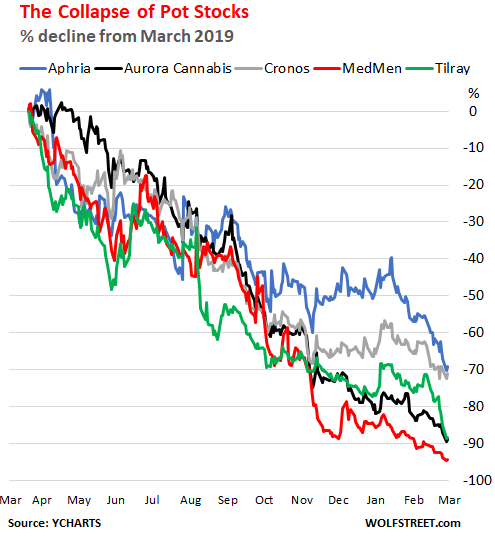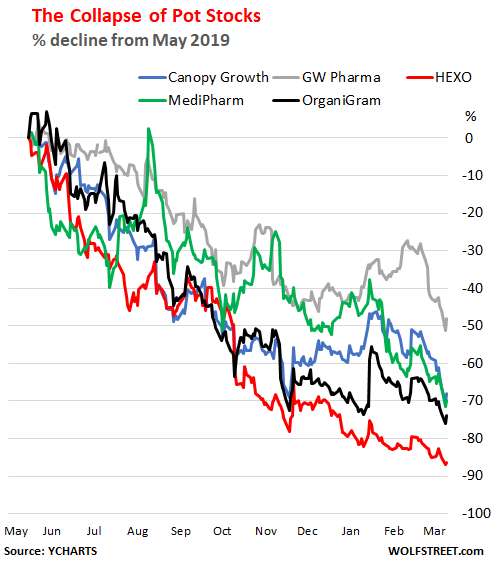Hard to feel sorry for victims of these hilariously obvious pump-and-dump schemes, but they sure got their pockets cleaned out.
By Wolf Richter for WOLF STREET.
There are plenty of questions surrounding cannabis – including whether or not it should be legal, and how it should be regulated and taxed. But there is no question surrounding “cannabis stocks”: They’re phenomenal pump-and-dump operations. And now is the dump-phase.
These are companies with barely any sales, generating huge losses. They were hyped endlessly by vocal promoters and by Wall Street which got rich off the IPO fees. The media oohed and aahed over the meteoric rise of their stocks and their market capitalization which skyrocketed into the many billions of dollars.
For example, Tilray [TLRY], which went public in July 2018, at $17 a share, skyrocketed to $300 a share, and its market cap hit $29 billion, by September 2018. That was the “pump” part of the pump-and-dump. Then the “dump” part commenced. Now the shares have collapsed by 97% to $7.84 and its market cap is down to $815 million.
Tilray has lost money every year of its existence, including $321 million in 2019, on $167 million in revenues. Yeah, these companies are trying to sell an agricultural product, and their net losses are double of what their revenues are. This takes some doing, folks.
Company after company did the same thing: Pump and dump to the max. And they did this in an environment where the products are still not legal in their largest market under US federal law, and where the long established and well-functioning black market is competing ferociously because it doesn’t have to follow rules and pay taxes, and where there are no barriers to entry, and where a surge of farming of cannabis created rampant supply that then caused prices to collapse.
To illustrate the overwhelming beauty of these pump-and-dump stocks on the dump-side of the deal, I have taken the 10 biggest pot stocks and divided them into two charts, with five stocks each, so that the colorful spaghetti doesn’t get too dense. These charts show the collapse in percentage terms from about a year ago. Note that a 100% collapse would mean the shares are worth zero. And that moment is coming up.
Here is the first group of five. The illustrious performance of this group of stocks ranges from -69% to -94% over the past 12 months (percent change data via YCHARTS):
- Aphria [APHA]: -69
- Aurora Cannabis [ACB]: -89%
- Cronos Group [CRON]: -71%
- MedMen [MMEN]: -94%
- Tilray [TLRY]: -88%

And here is the second group of five pot stocks whose illustrious performance since May 2019 ranges from -48% to -86% (percent change data via YCHARTS):
- GW Pharma [GWPH]: -48
- Canopy Growth [WEED.TO]: -68%
- MediPharm [LABS.TO]: -70%
- OrganiGram [OGI.TO]: -74%
- HEXO [HEXO]: -86%

When you look at this stuff, it’s hard to even feel sorry for the victims – the folks on the dump-part of the deal – whose pockets got cleaned out. I mean, I’m trying to feel sorry for them, but it’s just hard. They suckered themselves
The winners are those on the pump-side of the deal who then dumped their shares and got out in time. Kudos to them. They taught those folks a lesson about the price of consensual hallucination, and those folks paid their tuition, and hopefully the cost wasn’t devastating, but big enough so they’ll never forget, and so that next time, instead of falling for all the hype, they’ll think and look at financials before they buy this crap.
And this wealth transfer – that’s really all it was – predates the new coronavirus and for once, refreshingly, has nothing to do with the coronavirus or the sell-off in the markets or the collapse of the price of oil. It’s just purely and simply one more scheme in an endless series that blew up.